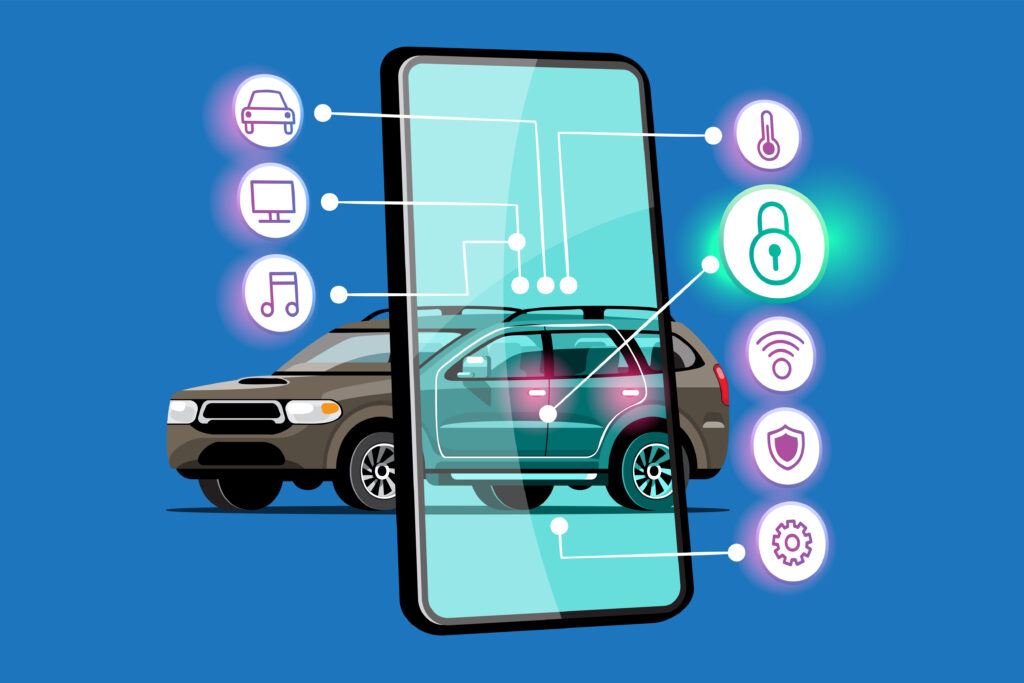What is a System on Chip (SoC)?
A System on Chip (SoC) is a single semiconductor device that holds all of the key elements that make up a computer system, including the computer’s central processing unit (CPU), memory, input/output, or I/O, the interfaces, and different peripheral devices.
System on a chip is seen as the future of cutting-edge automotive technologies for the reasons listed below.
- Compact and Lightweight: SoCs boast a reduced form factor and weight in comparison to multi-chip arrangements, making them a preferred choice for portable gadgets.
- Reduced Power Usage: SoCs can be engineered to operate with minimal power consumption this is a critical factor in prolonging the battery life of mobile devices.
- Cost-Efficiency: SoCs can be manufactured at a lower cost than multi-chip setups which results in more budget-friendly options for consumers.
Furthermore, SoCs provide various performance advantages.System on Chip can be configured to operate at a higher clock speed compared to multi-chip setups. This is attributed to the consolidation of all system components on a single chip, which minimizes the data transfer time between them.
SoCs are gaining traction in various sectors, including automotive, medical, and industrial systems. This growth is attributed to their ability to deliver the same advantages of reduced size, decreased power consumption, and cost-effectiveness, which they offer in the realm of mobile devices. Furthermore, SoCs can be tailored to meet the distinct demands of these applications, such as the necessity for enhanced reliability or resilience in challenging environmental conditions. SoCs represent a swiftly advancing technology, and their significance in driving the creation of fresh and inventive products is anticipated to persist.
Advance Features of System on Chip includes:
In the automotive sector, SoCs are employed to enable a broad spectrum of advanced functionalities, such as:
- Advanced driver-assistance systems (ADAS): ADAS functions like lane departure warning, automatic emergency braking, and adaptive cruise control depend on SoCs for handling sensor data and executing immediate actions.
- Edge AI: Edge AI denotes a form of artificial intelligence executed on the device itself, without reliance on cloud resources. SoCs are harnessed for driving edge AI applications within automobiles, like object recognition and anomaly detection.
- Connected car technologies: These technologies enable vehicles to communicate with each other and with infrastructure. SoCs are employed to enable these technologies, including vehicle-to-everything (V2X) communication and over-the-air (OTA) updates.
The Role of SoCs in ADAS Features
SoCs play a pivotal role in enabling a wide range of ADAS features, including:
- Lane Departure Warning (LDW): LDW systems utilize cameras to monitor the vehicle’s position relative to lane markings. When the vehicle unintentionally strays from its lane, the system alerts the driver through visual, auditory, or haptic feedback. SoCs process image data from the cameras and analyze lane markings to determine the vehicle’s position and issue timely warnings.
- Adaptive Cruise Control (ACC): ACC systems maintain a set distance from the vehicle ahead, automatically adjusting the vehicle’s speed to maintain a safe following distance. SoCs process sensor data and analyze the distance and speed of the preceding vehicle to control the vehicle’s throttle and brakes, maintaining a consistent following distance.
The Role of SoCs in Edge AI
SoCs play a pivotal role in enabling edge AI applications in automotive systems by providing the necessary processing power, low latency, and power efficiency. Modern SoCs incorporate various architectural features to support edge AI workloads:
- AI accelerators: AI accelerators includes neural processing units (NPUs) and tensor processing units (TPUs)that can greatly accelerate AI algorithm execution and enables real-time sensor data processing.
- Memory: SoCs with extensive on-chip memory can store AI models and intermediate data, eliminating the requirement for data transfer between the processor and external memory which enhances speed and lowering latency
- Sensor fusion: SoCs may combine data from various sensors such as cameras, radar, and lidar to provide more comprehensive and accurate situational awareness and decision-making.
The Role of SoCs in Connected Car Technologies
SoCs serve as the backbone of connected car systems, enabling various communication protocols and applications, including:
- Communication-to Vehicles (V2V): This type of communication protocols enables vehicles to share data about their position, speed, and direction, which in turn enables real-time collision avoidance and collaborative driving maneuvers.
- Communication-to-Infrastructures (V2I): V2I communication protocols allows vehicles to exchange information with elements of the infrastructure, including traffic lights, road sensors, and signs. This facilitates real-time traffic updates, adaptive traffic signal control, and the dissemination of warnings about potential hazards.
- Communication-to- Pedestrians (V2P): V2P communication protocols enables vehicles to interact with pedestrians, particularly those in vulnerable situations like blind spots or crosswalks, enhancing pedestrian safety.
SoCs play a vital role in the advancement of these sophisticated automotive technologies. Through the consolidation of multiple components onto a single chip, SoCs can diminish size, weight, power usage, and expenses. Additionally, they can enhance performance and dependability.
Lets see the benefits of System on Chip in automotive devices or applications:
- Diminished size and weight: SoCs can contribute to the reduction of automotive electronic components’ size and weight, which can lead to enhanced fuel efficiency.
- Decreased power usage: SoCs can assist in lowering the power consumption of automotive electronics, thereby extending the battery life of electric vehicles.
- Reduced expenses: SoCs can contribute to cost reductions in automotive electronics, ultimately making cars more budget-friendly.
- Enhanced performance: SoCs can play a role in enhancing the performance of automotive electronics, resulting in improved safety and convenience features.
- Enhanced dependability: SoCs can contribute to an increase in the reliability of automotive electronics, potentially reducing the necessity for repairs and maintenance.
With the ongoing advancement of technologies in the automotive sector, SoCs will take on an increasingly pivotal role. SoCs are essential for enabling the upcoming generation of secure, interconnected, and self-driving vehicles.
Future Trends and Innovations in Automotive SoCs
Automotive SoCs are rapidly evolving, incorporating AI, ML, and 5G connectivity to enable next-generation applications like autonomous driving, personalized experiences, and enhanced safety. Challenges include design complexity, software development, data management, and standardization. Opportunities lie in innovation across these areas.
Conclusion
As we conclude, it is evident that these tiny marvels of engineering are the driving force behind the transformation of the automotive industry. From enabling advanced driver-assistance systems to facilitating edge AI applications and connected car technologies, SoCs are paving the way for a safer, more efficient, and more intelligent driving experience.
Frequently Asked Questions
What is a System on Chip (SoC) in automotive technology?
SoCs in automotive technology are single semiconductor devices that integrate essential computer system components, reducing size and improving performance.
How do SoCs enhance safety in vehicles?
SoCs power advanced driver-assistance systems (ADAS) for features like lane departure warning and adaptive cruise control, making driving safer.
What’s the role of SoCs in edge AI for automobiles?
SoCs enable edge AI applications within vehicles, such as object recognition, by providing processing power and low latency.
How do SoCs contribute to connected car technologies?
SoCs serve as the foundation for V2V, V2I, and V2P communication, enhancing collaboration, traffic management, and pedestrian safety.



